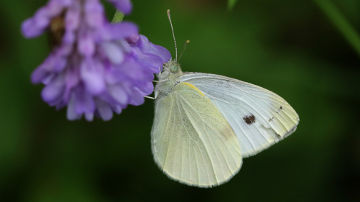

PHOTO COURTESY OF GARRY KESSLER
The cabbage white butterfly
September 28, 2018, Page A10-A11
NATURE NOTES
By Annie Reid
Westborough Community Land Trust
A common fall butterfly
Every fall, one butterfly you can count on seeing is the cabbage white. The same goes for spring and summer, even in a year such as this one when the numbers of butterflies in our area have seemed low.
You’ve probably noticed this white, medium-sized butterfly, with a 2-inch wing span, fluttering quickly along in sunny, open areas – fields, gardens, yards, roadsides, and vacant lots.
Take a closer look at a cabbage white (Pieris rapae) when one lands briefly on a plant. You can often tell males from females – something that you can’t easily do with most butterflies. How? Males have one black dot on each forewing, but females have two dots. Kids, especially, have fun spotting – or counting – males and females.
A view from above (wings open) shows black tips on the wings. A side view (wings closed) often reveals light yellow on the hindwings. And you might even notice green eyes.
Lovely as it is to see, the cabbage white is not a favorite of farmers and vegetable gardeners. As the name suggests, its caterpillars – the butterfly’s immature eating-and-growing stage – munch cabbage and other plants in the mustard family (Brassicaceae), such as radishes, turnips, kale, broccoli, cauliflower, and more. You’re likely to find the adult butterflies in gardens, where males look for mates and females search for plants to lay their eggs on. Cabbage white caterpillars also eat many wild plants in the mustard family, including invasive garlic mustard.
Would you be surprised to learn that this widespread butterfly came from Europe? Today it is often considered invasive here. It arrived accidentally in Montreal (Quebec province) in the 1860s and spread quickly. By 1900 it could be found across the U.S. In recent years, scientists have sequenced and studied the cabbage white’s genes, concluding that cabbage whites on this continent are so genetically similar that they all must have descended from a single female.
Some reasons for the cabbage white’s success are chemical. For one, its caterpillars can detoxify the mustard oils that their food plants produce to keep insects from eating them. Cabbage white caterpillars can feast on a wide range of plants that competing insects can’t eat.
Chemistry also comes to the aid of the soft, slim green caterpillars by providing a defense against certain insect predators, especially ants. On their body “hairs,” the caterpillars produce a sticky substance containing a chemical that repels ants.
When it comes to reproduction, chemistry helps cabbage whites spread widely. As a female lays tiny eggs one at a time on leaves, a chemical comes with them that discourages other females from laying eggs nearby. As a result, eggs are widely spread out in an area.
Cabbage whites reproduce throughout the growing season. In autumn, falling temperatures stimulate caterpillars to prepare to overwinter. They begin to produce antifreeze chemicals. Also, the protective chrysalises that they produce for overwintering are more likely to be brown – matching the winter surroundings – than in spring or summer, when green chrysalises are more common.
You can watch cabbage whites from April through November, but keep an eye out for other butterflies that you might still see in the fall: migrating monarchs and painted ladies, and others that stay local, such as clouded sulphurs, orange sulphurs, American coppers, gray hairstreaks, eastern tailed-blues, black swallowtails, viceroys, and mourning cloaks.
Date index
Month (September)
Common name index
Scientific name index
Category index